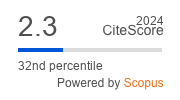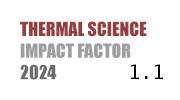THERMAL SCIENCE
International Scientific Journal
THERMAL EXTRACTION OF PECTIN FROM THE STEM BARK OF ECO-WOOD HIBISCUS AND ITS APPLICATION TO CASHMERE FABRICS
ABSTRACT
In this study, natural plant pectin was extracted from the stem bark of Hibiscus mutabilis and utilized to finish knitted cashmere fabrics. The performance differences between the fabrics before and after finishing were investigated. The results demonstrate that the extraction solution, comprising hibiscus stem bark tartaric acid at a pH of 2, extraction time of 90 minutes, and a material-liquid ratio of 1/30, yielded pectin at a yield of up to 13.24%. This yield is not as high as that of tartaric acid. Following the finishing of the knitted cashmere fabric with hibiscus pectin, a notable enhancement in the fabric's antibacterial and UV properties was observed. Following the application of a 7.5% hibiscus pectin solution, the transmission rate of UV light with a wavelength of less than 290 nm exhibited a tendency towards zero, while the ultraviolet protection factor value reached 43. Furthermore, the bacterial inhibition rate of Staphylococcus aureus was observed to reach 94.571%.
KEYWORDS
PAPER SUBMITTED: 2024-04-15
PAPER REVISED: 2024-05-30
PAPER ACCEPTED: 2024-05-30
PUBLISHED ONLINE: 2025-07-06
THERMAL SCIENCE YEAR
2025, VOLUME
29, ISSUE
Issue 3, PAGES [1731 - 1738]
- Lee, S. M., et al., Greatly Increased Toughness of Infiltrated Spider Silk, Science, 324 (2009), Apr., pp. 488-492
- Brainard, J., Silkworms Spin Spider Fibers, Science, 381 (2023), Sept., pp. 1379-1379
- Wang, Q. L., et al., Intelligent Nanomaterials for Solar Energy Harvesting: from Polar Bear Hairs to Un-smooth Nanofiber Fabrication, Front. Bioeng. Biotech., 10 (2022), 92625
- Tian, D., et al., Sea-Silk Based Nanofibers and Their Diameter Prediction, Thermal Science, 23 (2019), 4, pp. 2253-2256
- Zhou, C. J., et al., Silkworm-Based Silk Fibers by Electrospinning, Results in Physics, 15 (2019), 102646
- Yu, D. N., et al., Snail-Based Nanofibers, Materials Letters, 220 (2018), June, pp. 5-7
- Zhou, C. J., et al., Fabrication of Latex-Based Nanofibers by Electrospinning, Recent Patents on Nano-technology, 13 ( 2019), 3, pp. 202-205
- Tian, D., et al., Electrospun Mussel-Derived Silk Fibers, Recent Patents on Nanotechnology, 14 (2020), 1, pp. 14-20
- Yu, D. N., et al., Wetting and Supercontraction Properties of Spider-Based Nanofibers, Thermal Science, 23 (2019), 4, pp. 2189-2193
- He, J.-H., et al., The Maximal Wrinkle Angle During the Bubble Collapse and its Application to the Bubble Electrospinning, Frontiers in Materials, 8 (2022), 800567
- Qian, M. Y., He, J.-H., Collection of Polymer Bubble as a Nanoscale Membrane, Surfaces and Interface, 28 (2022), 101665
- Ali, M., et al., Double Bubble Electrospinning: Patents and Nanoscale Interface, Recent Patents on Nanotechnology, 18, On-line first, doi.org/10.2174/0118722105259729231004040238, 2024
- Qian, M. Y., et al., Enhanced Piezoelectric Performance of PVDF Nanofibers by Biomimicking the Spider's Long Liquid Transport, Chemical Engineering Journal, 483 (2024), 149159
- Haddar, W., et al., A Novel Approach for a Natural Dyeing Process of Cotton Fabric with Hibiscus Mutabilis (Gulzuba): Process Development and Optimization Using Statistical Analysis, Journal of Cleaner Production, 68 (2014), Apr., pp. 114-120
- Shanker, R., Vankar, P. S., Dyeing Cotton, Wool and Silk with Hibiscus Mutabilis (Gulzuba), Dyes and Pigments, 74 (2007), 2, pp. 464-469
- Xie, J. E., et al., Mechanochemical-assisted Efficient Extraction of Rutin from Hibiscus Mutabilis L., Innovative Food Science & Emerging Technology, 12 (2011), 2, pp. 146-152
- Sun, Y., et al., Research on Experimental Parameters Selection for Measuring Thermal Diffusivity by Laser Flash Method at Room Temperature, Thermal Science, 28 (2024), 2C, pp. 1717-1728

